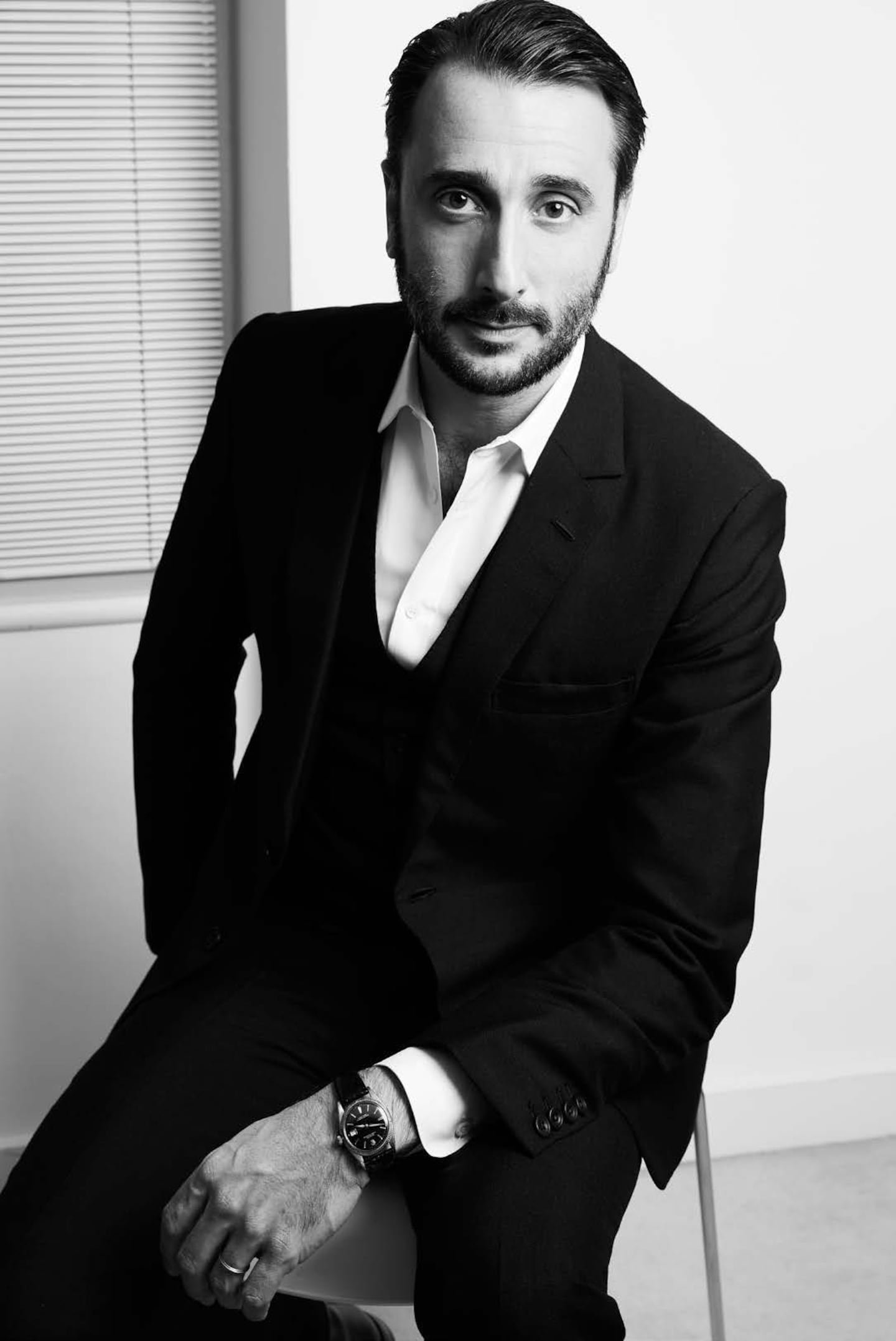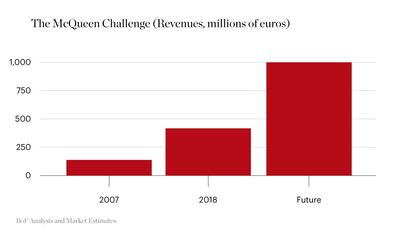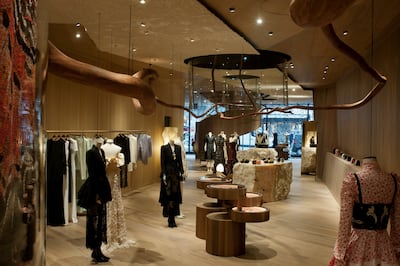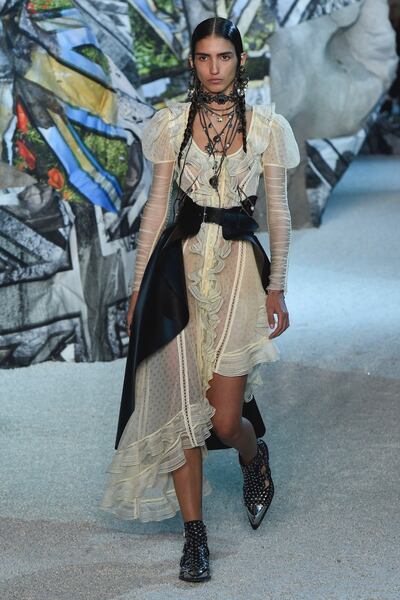
The Business of Fashion
Agenda-setting intelligence, analysis and advice for the global fashion community.

Agenda-setting intelligence, analysis and advice for the global fashion community.

LONDON, United Kingdom — Back in 2010, after the sudden death of Lee Alexander McQueen, some industry observers questioned whether his namesake brand, still young compared to the goliaths of the luxury business, could survive without its visionary founder.
But Alexander McQueen's parent company — then called PPR, now Kering — believed there was strong business potential and vowed to push ahead. The brand's creative leadership was passed to Sarah Burton, formerly McQueen's head of womenswear for a decade, who said at the time: "The creation of modern beautifully crafted clothes was at the heart of Lee's vision. I intend to stay true to his legacy."
Since then, Burton has done just that, remaining faithful to the codes of the house, rooted in the life cycle of nature in all its beauty and terror, as Kering invested heavily in retail expansion. This has been critical to the continued growth of the business. Back in 2010, the year McQueen died, the brand had 11 directly operated stores, with estimated revenues of less than €100 million. Today, revenues are estimated to be between €350 million and €400 million, with 64 directly-operated stores. (Kering does not break out financials for the smaller brands in its portfolio.)

Now, the Alexander McQueen brand faces a bigger challenge. After a wider review of its portfolio, Kering has set ambitious new targets for the label, which the group believes has the potential to surpass €1 billion in annual sales. But what will it take for McQueen to follow in the footsteps of successful stablemates like Gucci, Saint Laurent and Balenciaga?
ADVERTISEMENT
While there is no single formula for success in luxury fashion, there are some tried-and-tested strategies that have proven to be effective time and again. And yet, McQueen is a unique brand with idiosyncrasies and peculiarities that make scaling the brand more challenging.
In a luxury market largely driven by sales of accessories, McQueen is better known for its ready-to-wear. Handbags are cost-effective status anchors that can be easily mixed and matched with other items and worn regularly by consumers. They also drive higher sales productivity (sales per square foot) and higher profit margins for brands. By contrast, ready-to-wear businesses are notoriously hard to scale because clothing comes with the additional complexity of sizing, fitting and seasonal variations that come in and out of fashion. This requires more agile and adept supply chains to ensure the right products are in the right place in the right size at the right time. What’s more, in a luxury goods market tied to new wealth creation, first-time luxury consumers often do not buy into ready-to-wear because these items don’t offer as much bang for the buck as accessories.
Today, McQueen is a medium-sized luxury business, about 20 percent the size of Saint Laurent, for example. But it’s also relatively young, without the global brand recognition and age-old codes of some of its peers. While McQueen certainly got a boost in recent years from the blockbuster exhibition at the Metropolitan Museum of Art and the wedding of Kate Middleton to Britain’s Prince William, for which the bride wore McQueen, the brand is still honing what it stands for and determining how to turn that into consistently marketable products that will sell over time.
All of this makes the McQueen challenge a formidable one. But chief executive Emmanuel Gintzburger says the brand is on the right track. A seasoned luxury executive with training at Louis Vuitton, Saint Laurent and Lanvin, Gintzburger joined the brand in 2016, following the departure of long-time chief Jonathan Akeroyd who left to lead Versace.
For our latest CEO Talk, BoF’s Imran Amed sat down with Gintzburger to unpack the game plan just as McQueen fêted the revamp of its flagship on London’s Bond Street.
BoF: Let’s start back in 2010 when Alexander Lee McQueen died — before you had joined the business. The biggest question people were asking was: ‘Can this brand survive without its founder?’ What is it about this brand that has enabled to it to survive — and thrive?
Emmanuel Gintzburger: I think it is a mix of factors. First is the talent of Sarah [Burton], and her capacity to bring the brand forward. Then there is the support of the group and François-Henri [Pinault]. There's also a moment in fashion where the brand is still extremely relevant today based on what we stand for in creativity.
Sarah’s been helping build the codes of the house almost since day one. She’s been building an incredible studio. She stands for freedom of expression and integrity. And she has also regrouped every single element and complexity of the brand; on the one side British culture, on the other side human beings; the tension between being extremely strong and also being very vulnerable, being hyper-feminine but also [having] an element of masculinity — the romance and the rebellion. So the potential of the house relies mainly on the expression of this vision and our capacity to build communities that want to share these values [and] the essence of the brand.
ADVERTISEMENT
The brand is right and the creativity behind the brand is right. It has always been right. Now, we're finishing a comprehensive re-alignment of the company to make sure that the expression of this vision is respectful. First we had to — let's say consolidate — the formation of the house and put in place operational processes to make sure we could get ready to grow. The challenge is not how fast you can grow, it is how well you can grow fast.
The challenge is not how fast you can grow, it is how well you can grow fast.
BoF: You mentioned the group. There's been a lot of change at Kering. They've been divesting of certain brands that don't fit into the luxury category. Some of the smaller brands have decided to go their own ways. So the pressure and expectation on brands like McQueen and Balenciaga is really big to drive the overall growth of the group as Gucci and Saint Laurent inevitably begin to slow. What will it take to build McQueen into a billion-euro business?
EG: The brand has tremendous potential. It could be one of the leading luxury houses in the world when you look at the assets and the creativity behind the house. The beauty of fashion, and the beauty of this house, is not about replicating formulas from brand to brand. McQueen has built a tremendous leadership and authority in ready-to-wear — already today we're selling more ready-to-wear than other brands that are already above the one-billion mark. What is distinctive about McQueen is not one specific category, it's a very specific silhouette.
BoF: Yes, for example the cinched waist and sharp shoulder, right?
EG: Yes, when I think of McQueen [I think of] the fit; the shape, the shoulder, right? So you have in mind a very distinctive silhouette. And [the question is] how this silhouette can [adapt] to every single category. It can be jewellery, it can be shoes, it can be bags. It's not about pushing one specific category, it’s about bringing forward a very distinctive silhouette that you might not have anywhere else and making sure they see [that] is completely fulfilled by every single category.
The experience of the Bond Street store is exactly what we stand for. When you think about McQueen, you think about a creative experience. So we think about how you translate that creativity into the physical world.
A few weeks ago we opened the second floor [of the store]. The whole point was to make sure we can immerse people, creative students into our creative process, opening up the brand to the public and giving back what we’ve learned. We will have a succession of talks and exhibitions on that floor, and it's open to anyone. We invited students from London schools but also from Liverpool and Manchester. It was basically an explanation and walkthrough [of Sarah’s] creative process. And this is a way to connect and to build creative communities. This is the future of our retail experience, making sure you move from a very exclusive and maybe too-transactional space into a highly inclusive and inspirational space.

The revamped Alexander McQueen store on Bond Street, London | Source: Courtesy
BoF: There's no doubt that this is a highly creative brand. And the shows are almost like couture. The level of craftsmanship and creativity in those shows is incredible. But then, if someone's going down from the second floor to the first floor, the question is what are they going to buy? You've pointed out that ready-to-wear is a strong category, but not everyone can fit into a beautiful Alexander McQueen cinched dress or sharp suit. Most houses are driven by accessories, leather goods, shoes. What are your plans in those categories?
ADVERTISEMENT
EG: For sure, those categories are essential. Today it’s shoes and accessories that are growing the fastest. We're in the triple-digit growth on those categories, which is a catch-up. When you talk about silhouette, you can talk about [it in] every single category and that's the beauty. And this is why, when we started to accelerate the expansion by saying that we want to double the [store] network, [we understood] you obviously need to have a [greater] density of successful categories as well. What was quite amazing, is that when we started to address this, we had significant support from our wholesale partners because we have a very distinctive silhouette and because we have a specific proposition. We're not cannibalising anybody.
And this is what we’ve been seeing. Bond Street again, [or] Dubai a few days ago when we opened. Shanghai a few weeks ago. When we have this complete perception of brand — because as you said the show has always been very strong for us, and the campaign — now we have the full physical space that can explain and project more.
BoF: You spent some time at Saint Laurent. One of the strengths of that house has been merchandising.: being able to take creativity and turn it into products, as part of the creative process. In the traditional fashion process, the merchandising would come at the end of the creative process. What's the merchandising process that you're putting in place at McQueen to translate the creativity into products to fill the new stores?
EG: We are lucky to have teams that have been here for 15-20 years, within the merchandising team [too]. So, for me, they are the guardians of the integrity of the brand. No matter what we do, they are the ones that protect the integrity and the values. They are completely integrated into the studio. And this is not new, and this has been the case for years. So, we’re obviously reinforcing the team and bringing in people with international skills and backgrounds that can enrich this dynamic. It has to feel McQueen, it has to be McQueen. So, the merchandising is not at the end of the process, the same way retail cannot be at the end of the process. It’s not a strict translation at the end of the story of the creative vision — it has to [happen] at the same time. It’s very integrated. The integration of merchandising and the creative studio, the integration of the [retail] concept and the studio, is absolutely critical. That’s what makes the brand right.

Alexander McQueen Spring/Summer 2019 | Source: Indigital.tv
[ View CollectionOpens in new window ]
BoF: Can you lay out the strategy around retail and how that links up with what you're doing digitally? You currently have 64 stores. As a brand that doesn’t necessarily already have 500 stores like Gucci, how do you think about the long-term strategy for retail, how does this fit with the e-commerce offer?
EG: McQueen is not only a brand that you buy, it is [also] a house where you're trying to feel a creative experience. You need to feel something, and this is why you go to McQueen. We have 64 stores but the potential is much larger, still keeping a very exclusive and relevant distribution. We’ve started a cycle of store openings in key capital cities, starting with Bond Street, then Dubai, Hong Kong and Tokyo. There will also be Milan, Paris and all this is happening within the next 16 months.
But when we approach this development, we do not approach it by channel — it’s not either retail or wholesale — it’s what makes sense by city in terms of integrated distribution. And if you think about China for example, where we started to partner with digital platforms and also have our own website and are developing our own network of stores, we focus on making sure that we have an ecosystem that makes sense from a client standpoint, being totally integrated. We have been very successful in digital and e-commerce in the past year and a half with high triple-digit growth. This makes sense because there is a full consistency between the product, the imagery and the experience that you have. This also gives us confidence. The acceleration of our site in cities where we are not [present], but also in cities where we are starting to expand, integrated with our [directly operated stores], became extremely relevant. So, it’s not either all retail or all digital or all wholesale, it’s a matter of what makes sense [in each city]. In some cities or countries it makes sense to have all three, in some cities and countries it makes sense to have only two. In the end, it’s about how you can better express the brand.
BoF: But it seems like your strategy is for retail to take a larger proportion of the overall total?
EG: Wholesale is essential for us. The same way we’re expanding retail, it’s also to give access to the brand to more people. And for sure, wholesale — be it in the US or Europe — can give us access to clients that we would never ever connect with through our pure directly operated store network. So, it’s a matter of working with key partners on the consistency of the brand expression, on the appeal of the assortment, on the density of the brand — and that’s what we’ve been started doing with some key partners, in the US for example. How can we also make sure we build a supply chain that is reactive, smart and agile enough to fulfil those stores and not rely on shipments every 6 months? It’s like the retailisation of our wholesale model.
BoF: So, you have strong creative platform, strong brand DNA, resources to expand the retail network, integrated merchandising and creativity. What are the biggest challenges you’re facing?
EG: It’s a good question. I think it’s about never, ever compromising on what you, either as an individual or as a brand, stand for. Yes, you can grow, and you can expand, and you can develop and recruit more people. But how do you make sure that by doing this, you have a meaningful expansion and meaningful success? So, it’s not only about how much I'm going to reach, it’s about how we will reach it, which is also very close to the values that we have in the group. It’s like “yes, we need to excel, we need to grow, we need to strengthen the activity of the house.” But how do we do it? How? This is meaningful for the people we have, for the history and the respect we have for the people who’ve been in the house over the past few years, and also for the people who joined.
There is also the capacity to test, try, fail, create, learn, start again and move forward while being aware of what is happening around us. For example, Brexit is not good news for us, it’s not good news for the industry, it’s not going to help us recruit to help to grow our talent, however we’re going to stay agile and adapt.
Related Articles:
[ How François-Henri Pinault Unites Profits and PurposeOpens in new window ]
[ Kering's Bigger, Bolder Plan for Alexander McQueenOpens in new window ]
[ Inside the Alexander McQueen DocumentaryOpens in new window ]
The former CFDA president sat down with BoF founder and editor-in-chief Imran Amed to discuss his remarkable life and career and how big business has changed the fashion industry.
Luxury brands need a broader pricing architecture that delivers meaningful value for all customers, writes Imran Amed.
Brands from Valentino to Prada and start-ups like Pulco Studios are vying to cash in on the racket sport’s aspirational aesthetic and affluent fanbase.
The fashion giant has been working with advisers to study possibilities for the Marc Jacobs brand after being approached by suitors.